Effect of Inflation and Permitted Three-Slot Payment on Two-Warehouse Inventory System with Stock-Dependent Demand and Partial Backlogging
Abstract
1. Introduction
2. Model Description
2.1. Assumptions
- The OW has limited capacity, whereas the capacity of RW is unlimited;
- Items stored in RW are sold first due to higher holding costs;
- Zero lead is considered upon reordering;
- The planning horizon and replenishment rate are infinite;
- We consider linear stock-dependent demand D(t);
- Demands in the stock-out period are partially backlogged;
- Supplier permits the retailer three-slot payment options on paying purchasing costs;
- Retailers may pay one-third of the purchasing cost with a discount at the time epoch P1 prior to the replenishment point;
- The second part of the purchasing cost is settled at time epoch P2 of the replenishment point;
- The third part of the purchasing cost is paid with a penalty at time epoch P3 which is posterior to the replenishment point;
- The effect of inflation is considered, and also time-dependent value of money is taken into account;
- Deterioration starts immediately after purchasing the items but the rate of deterioration is different in both warehouses due to their existing facilities.
2.2. Model Specifications
3. Numerical Illustration and Sensitivity Analysis
3.1. Numerical Illustration
3.2. Sensitivity Analysis
3.2.1. Environment with Varying Rate of Inflation
3.2.2. Environment with Varying Rate of Backlogging
3.2.3. Environment with Varying Rate of Discount
3.2.4. Environment with Varying Rate of Penalty
4. Conclusions
Author Contributions
Funding
Data Availability Statement
Conflicts of Interest
List of Symbols
| Ordering cost per order | |
| Inventory holding cost per item in the unit of time in RW. | |
| Inventory holding cost per item in the unit of time in OW. | |
| Deterioration cost per item in the unit of time in RW. | |
| Deterioration cost per item in the unit of time in OW. | |
| Purchasing cost per item in the unit of time. | |
| Shortage cost per item in the unit of time. | |
| Last sale cost per item in the unit of time. | |
| , and are positive constants | |
| Deterioration rate in RW. | |
| Deterioration rate in OW. | |
| Discount rate for pre-payment. | |
| Penalty rate for late payment. | |
| Rate of partial backlogging. | |
| Net discount rate of inflation and is constant here is discount rate and is inflation rate. | |
| Points at which partial prior payments are performed by the retailer. | |
| Points at which partial on time payments are performed by the retailer. | |
| Points at which partial posterior payments are performed by the retailer. | |
| Level of inventory at in RW. | |
| Level of inventory at in OW. | |
| Total inventory to be ordered. | |
| Partial backlogged inventory. | |
| Point at which the inventory level reaches zero in RW. | |
| Point at which the inventory level reaches zero in OW. | |
| Length of the entire replenishment cycle. | |
| Rental charge of per unit of time. | |
| Differentiation of with respect to . |
References
- Rezagholifam, M.; Sadjadi, S.J.; Heydari, M.; Karimi, M. Optimal pricing and ordering strategy for non-instantaneous deteriorating items with price and stock sensitive demand and capacity constraint. Int. J. Syst. Sci. Oper. Logist. 2022, 9, 121–132. [Google Scholar] [CrossRef]
- Ghiami, Y.; Beullens, P. The continuous resupply policy for deteriorating items with stock-dependent observable demand in a two-warehouse and two-echelon supply chain. Appl. Math. Model. 2020, 82, 271–292. [Google Scholar] [CrossRef]
- Pando, V.; San-José, L.A.; Sicilia, J. An inventory model with stock-dependent demand rate and maximization of the return on investment. Mathematics 2021, 9, 844. [Google Scholar] [CrossRef]
- Kumar, A.; Chanda, U. Two-warehouse inventory model for deteriorating items with demand influenced by innovation criterion in growing technology market. J. Manag. Anal. 2018, 5, 198–212. [Google Scholar] [CrossRef]
- Rana, R.S.; Kumar, D.; Mor, R.S.; Prasad, K. Modelling the impact of demand disruptions on two warehouse perishable inventory policy amid COVID-19 lockdown. Int. J. Logist. 2021, 1–23. [Google Scholar] [CrossRef]
- Seifert, D.; Seifert, R.W.; Isaksson, O.H.D. A test of inventory models with permissible delay in payment. Int. J. Prod. Res. 2017, 55, 1117–1128. [Google Scholar] [CrossRef]
- Tavakoli, S.; Taleizadeh, A.A. An EOQ model for decaying item with full advanced payment and conditional discount. Ann. Oper. Res. 2017, 259, 415–436. [Google Scholar] [CrossRef]
- Saren, S.; Sarkar, B.; Bachar, R.K. Application of various price-discount policy for deteriorated products and delay-in-payments in an advanced inventory model. Inventions 2020, 5, 50. [Google Scholar] [CrossRef]
- Shaikh, A.A.; Cárdenas-Barrón, L.E.; Manna, A.K.; Céspedes-Mota, A.; Treviño-Garza, G. Two level trade credit policy approach in inventory model with expiration rate and stock dependent demand under nonzero inventory and partial backlogged shortages. Sustainability 2021, 13, 13493. [Google Scholar] [CrossRef]
- Taleizadeh, A.A.; Tavakoli, S.; San-José, L.A. A lot sizing model with advance payment and planned backordering. Ann. Oper. Res. 2018, 271, 1001–1022. [Google Scholar] [CrossRef]
- Çalışkan, C. An inventory ordering model for deteriorating items with compounding and backordering. Symmetry 2021, 13, 1078. [Google Scholar] [CrossRef]
- Khan, M.A.-A.; Shaikh, A.A.; Cárdenas-Barrón, L.E.; Mashud, A.H.M.; Treviño-Garza, G.; Céspedes-Mota, A. An inventory model for non-instantaneously deteriorating items with nonlinear stock-dependent demand, hybrid payment scheme and partially backlogged shortages. Mathematics 2022, 10, 434. [Google Scholar] [CrossRef]
- Chung, K.-J.; Liao, J.-J.; Lin, S.-D.; Chuang, S.-T.; Srivastava, H.M. The inventory model for deteriorating items under conditions involving cash discount and trade credit. Mathematics 2019, 7, 596. [Google Scholar] [CrossRef]
- Shah, N.H.; Naik, M.K. EOQ model for deteriorating item under full advance payment availing of discount when demand is price-sensitive. Int. J. Supply Chain Oper. Resil. 2018, 3, 163. [Google Scholar] [CrossRef]
- Li, R.; Liu, Y.; Teng, J.-T.; Tsao, Y.-C. Optimal pricing, lot-sizing and backordering decisions when a seller demands an advance-cash-credit payment scheme. Eur. J. Oper. Res. 2019, 278, 283–295. [Google Scholar] [CrossRef]
- Sadikur Rahman, M.; Al-Amin Khan, M.; Abdul Halim, M.; Nofal, T.A.; Akbar Shaikh, A.; Mahmoud, E.E. Hybrid price and stock dependent inventory model for perishable goods with advance payment related discount facilities under preservation technology. Alex. Eng. J. 2021, 60, 3455–3465. [Google Scholar] [CrossRef]
- Ahmed, W.; Moazzam, M.; Sarkar, B.; Ur Rehman, S. Synergic effect of reworking for imperfect quality items with the integration of multi-period delay-in-payment and partial backordering in global supply chains. Engineering 2021, 7, 260–271. [Google Scholar] [CrossRef]
- Khan, M.A.-A.; Shaikh, A.A.; Panda, G.C.; Bhunia, A.K.; Konstantaras, I. Non-instantaneous deterioration effect in ordering decisions for a two-warehouse inventory system under advance payment and backlogging. Ann. Oper. Res. 2020, 289, 243–275. [Google Scholar] [CrossRef]
- Yang, H.-L.; Chang, C.-T. A two-warehouse partial backlogging inventory model for deteriorating items with permissible delay in payment under inflation. Appl. Math. Model. 2013, 37, 2717–2726. [Google Scholar] [CrossRef]
- Mondal, R.; Shaikh, A.A.; Bhunia, A.K.; Hezam, I.M.; Chakrabortty, R.K. Impact of trapezoidal demand and deteriorating preventing technology in an inventory model in interval uncertainty under backlogging situation. Mathematics 2021, 10, 78. [Google Scholar] [CrossRef]
- Kumar, N.; Singh, S.R.; Kumari, R. Learning effect on an inventory model with two-level storage and partial backlogging under inflation. Int. J. Serv. Oper. Manag. 2013, 16, 105. [Google Scholar] [CrossRef]
- Avdiu, K.; Unger, S. Predicting inflation—A holistic approach. J. Risk Fin. Manag. 2022, 15, 151. [Google Scholar] [CrossRef]
- Bhunia, A.K.; Shaikh, A.A.; Gupta, R.K. A study on two-warehouse partially backlogged deteriorating inventory models under inflation via particle swarm optimisation. Int. J. Syst. Sci. 2015, 46, 1036–1050. [Google Scholar] [CrossRef]
- Alamri, O.A.; Jayaswal, M.K.; Khan, F.A.; Mittal, M. An EOQ model with carbon emissions and inflation for deteriorating imperfect quality items under learning effect. Sustainability 2022, 14, 1365. [Google Scholar] [CrossRef]

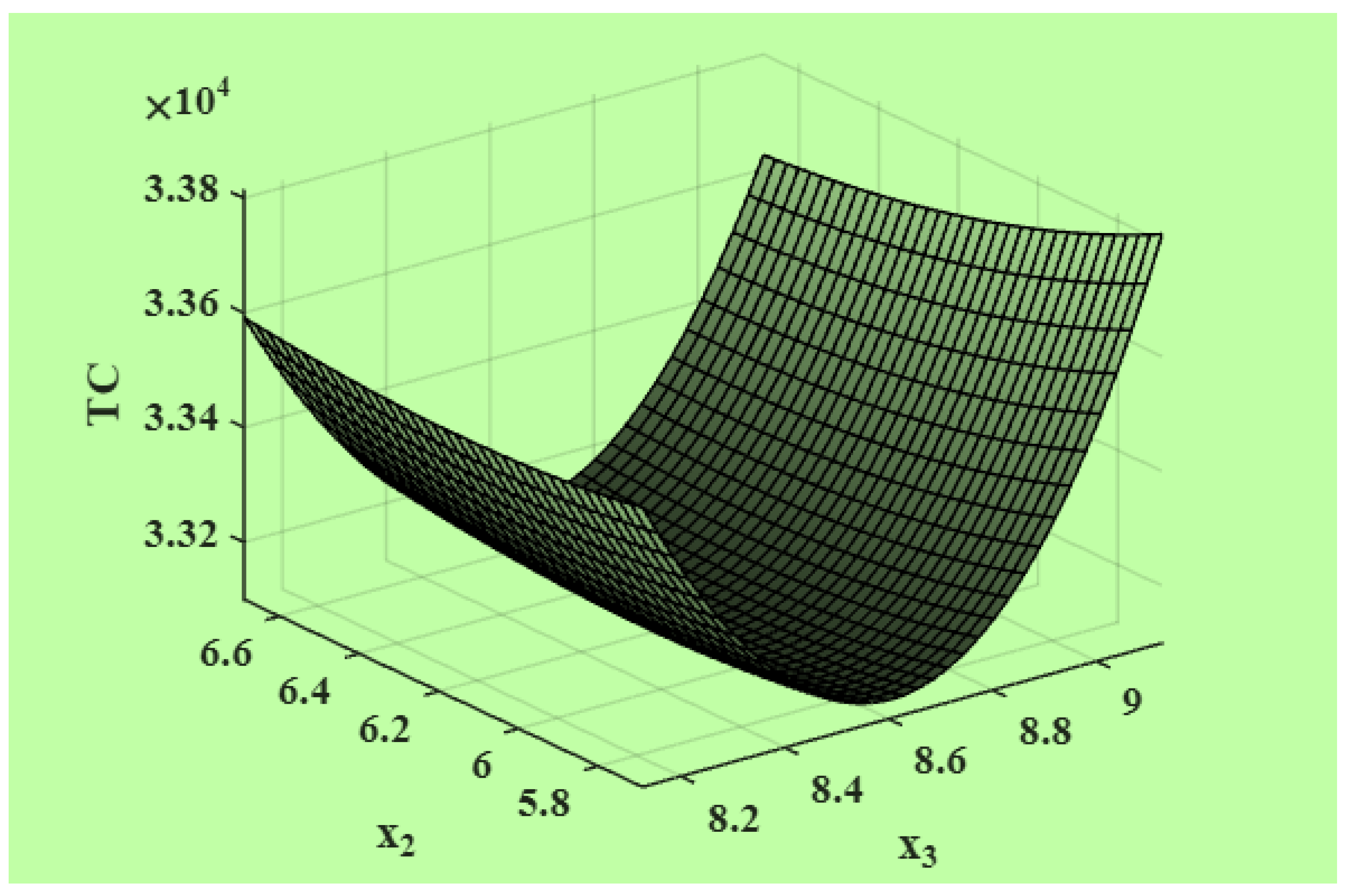
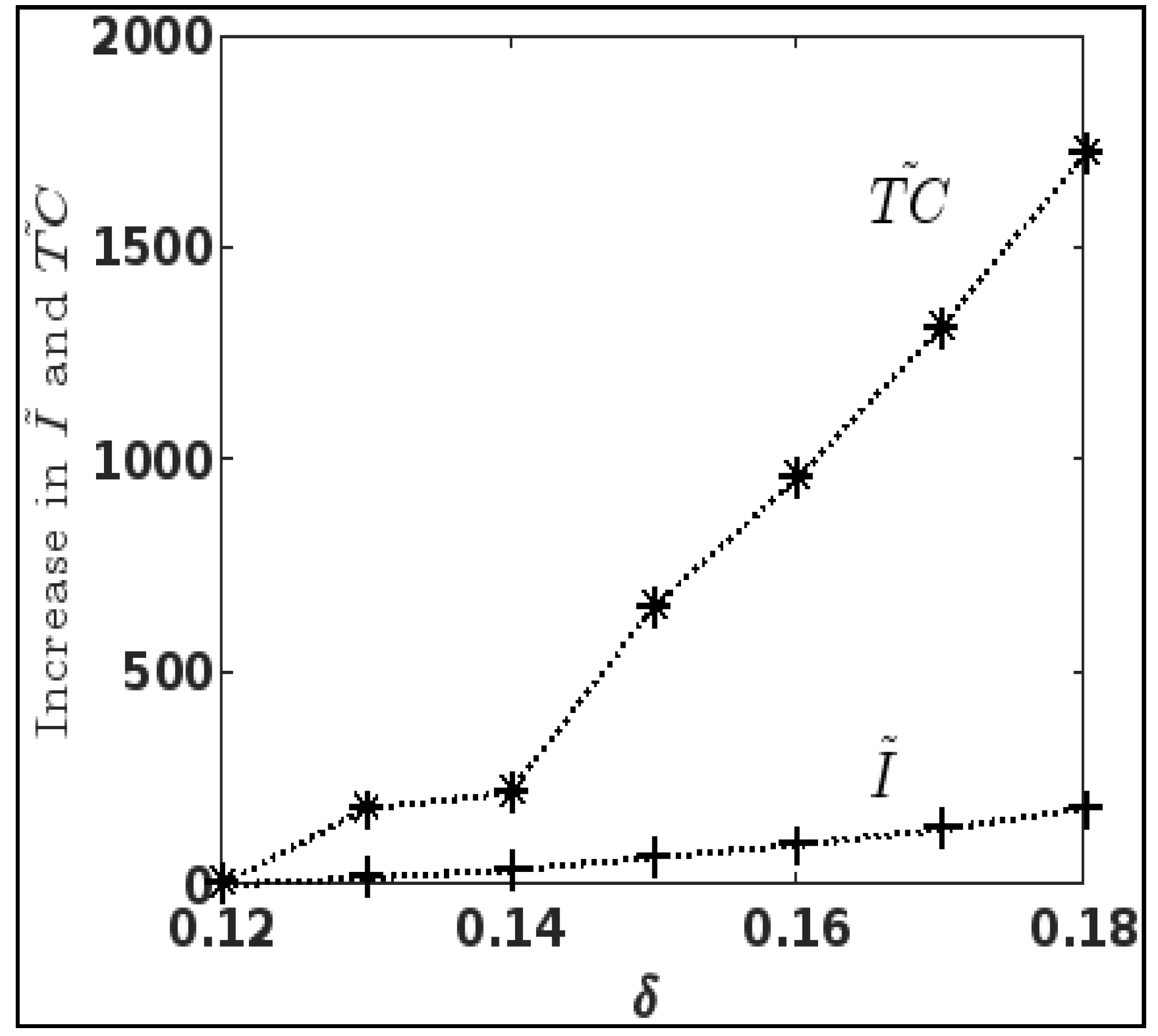
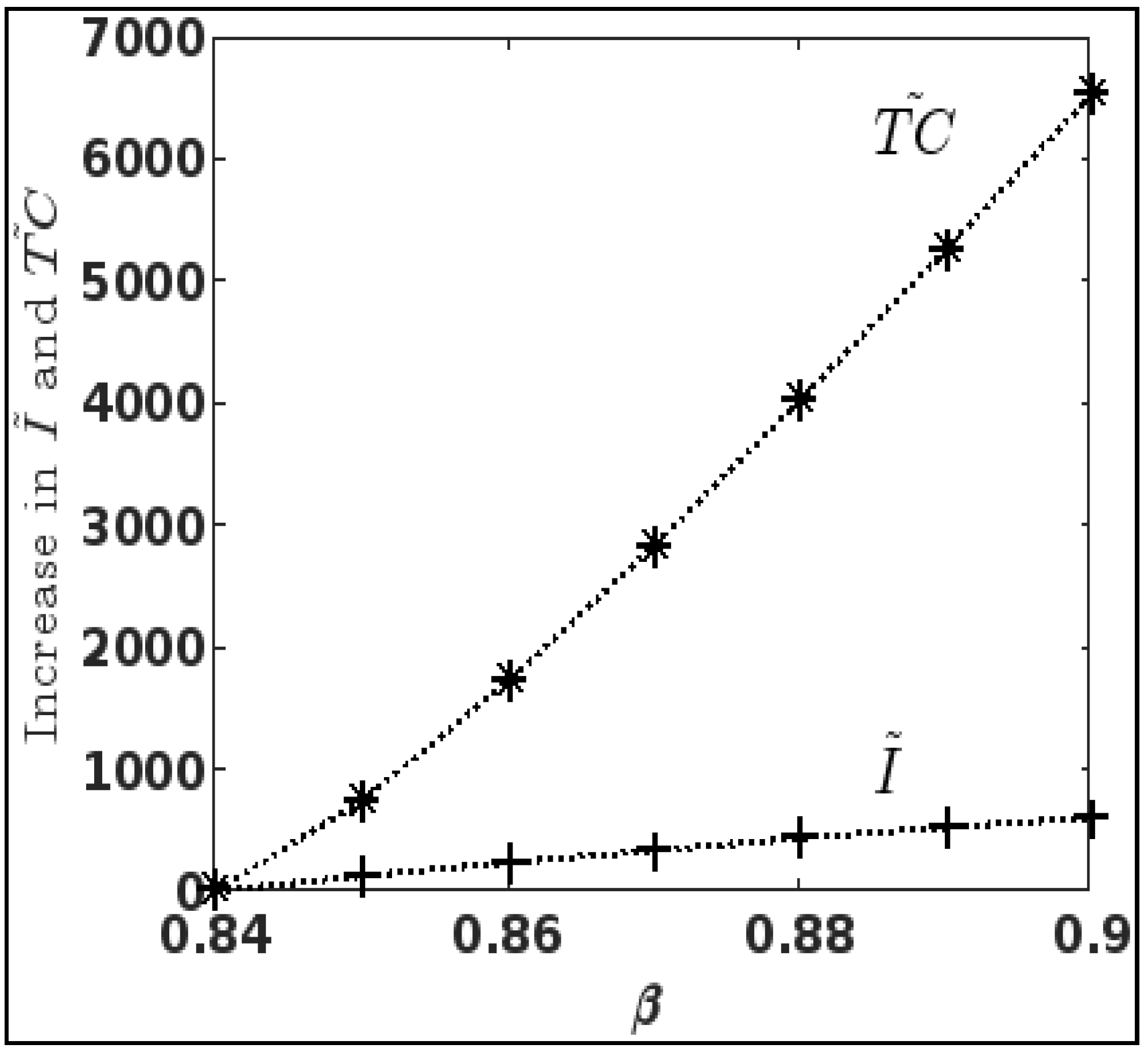
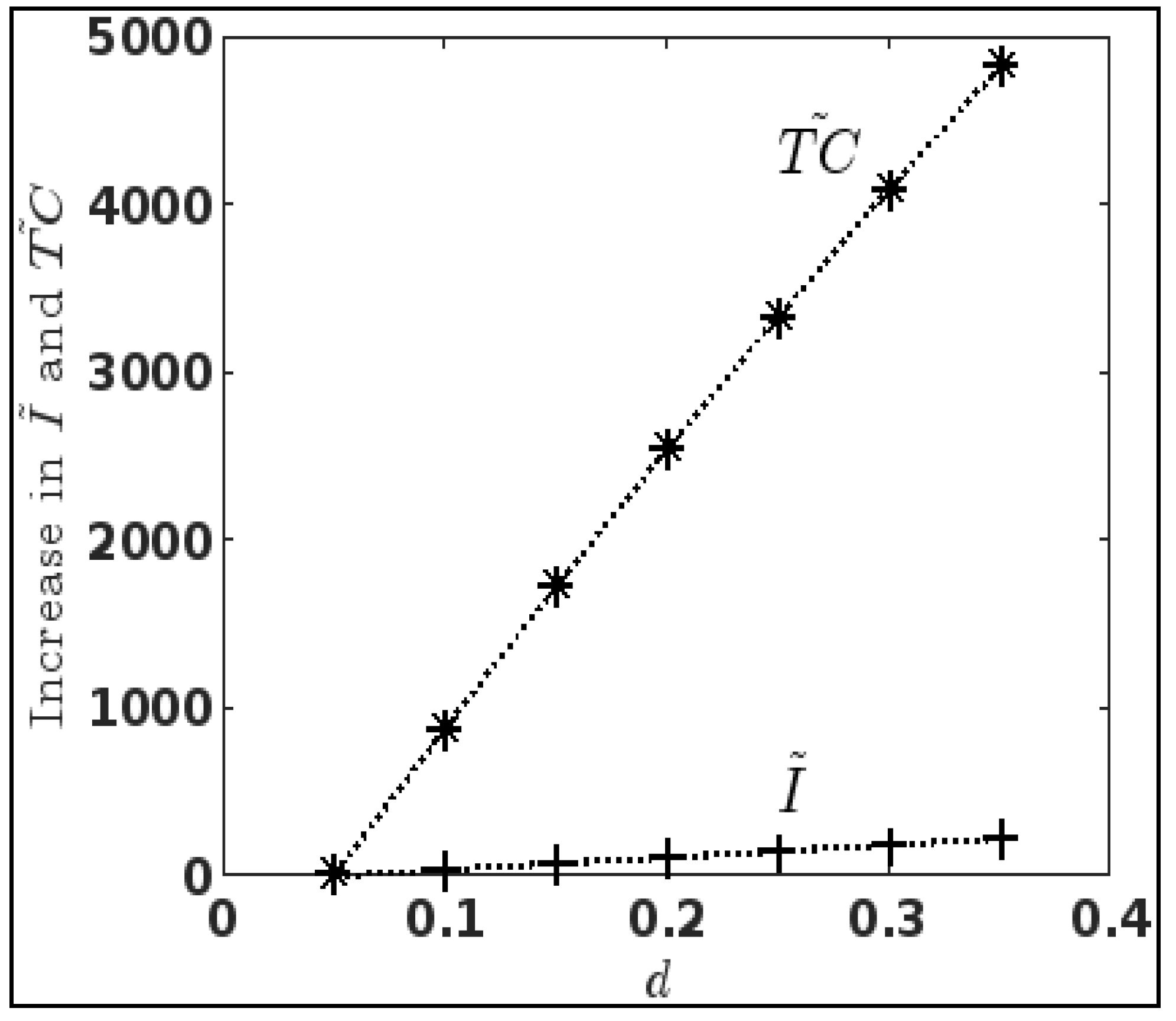
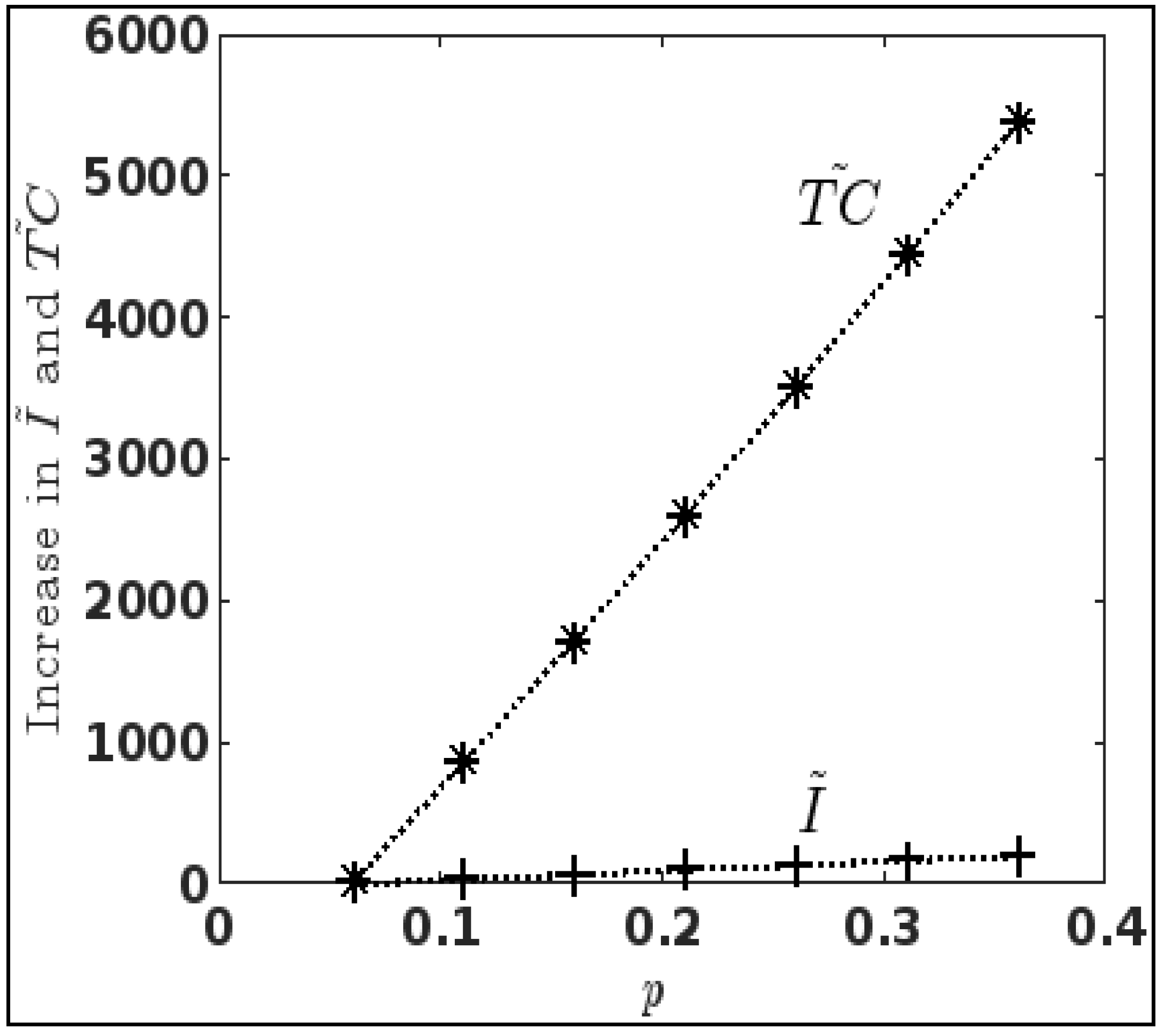
| R | StockOut Period | Increase in | Increase in | ||
|---|---|---|---|---|---|
| 1.46 | 0 | 0 | |||
| 1.52 | 16 | 180 | |||
| 1.59 | 35 | 215.99 | |||
| 1.7 | 65 | 653.41 | |||
| 1.81 | 94 | 956.69 | |||
| 1.94 | 130 | 1310.29 | |||
| 2.08 | 181 | 1717.78 |
| StockOut Period | Increase in | Increase in | |||
|---|---|---|---|---|---|
| 0.46 | 0 | 0 | |||
| 0.92 | 125 | 734.13 | |||
| 1.32 | 234 | 1711.81 | |||
| 1.7 | 333 | 2826.17 | |||
| 2.05 | 434 | 4019.74 | |||
| 2.38 | 524 | 5260.64 | |||
| 2.68 | 605 | 6530.98 |
| StockOut Period | Decrease in | Decrease in | |||
|---|---|---|---|---|---|
| 1.7 | 0 | 0 | |||
| 1.56 | 38 | 872.35 | |||
| 1.42 | 76 | 1718.54 | |||
| 1.29 | 111 | 2537.22 | |||
| 1.15 | 149 | 3326.92 | |||
| 1.01 | 186 | 4085.94 | |||
| 0.87 | 224 | 4812.43 |
| StockOut Period | Increase in | Increase in | |||
|---|---|---|---|---|---|
| 1.7 | 0 | 0 | |||
| 1.81 | 29 | 844.41 | |||
| 1.94 | 65 | 1710.08 | |||
| 2.07 | 100 | 2596.24 | |||
| 2.19 | 132 | 3502.17 | |||
| 2.31 | 164 | 4427.26 | |||
| 2.44 | 199 | 5370.95 |
Publisher’s Note: MDPI stays neutral with regard to jurisdictional claims in published maps and institutional affiliations. |
© 2022 by the authors. Licensee MDPI, Basel, Switzerland. This article is an open access article distributed under the terms and conditions of the Creative Commons Attribution (CC BY) license (https://creativecommons.org/licenses/by/4.0/).
Share and Cite
Thilagavathi, R.; Viswanath, J.; Cepova, L.; Schindlerova, V. Effect of Inflation and Permitted Three-Slot Payment on Two-Warehouse Inventory System with Stock-Dependent Demand and Partial Backlogging. Mathematics 2022, 10, 3943. https://doi.org/10.3390/math10213943
Thilagavathi R, Viswanath J, Cepova L, Schindlerova V. Effect of Inflation and Permitted Three-Slot Payment on Two-Warehouse Inventory System with Stock-Dependent Demand and Partial Backlogging. Mathematics. 2022; 10(21):3943. https://doi.org/10.3390/math10213943
Chicago/Turabian StyleThilagavathi, Rajamanickam, Jagadeesan Viswanath, Lenka Cepova, and Vladimira Schindlerova. 2022. "Effect of Inflation and Permitted Three-Slot Payment on Two-Warehouse Inventory System with Stock-Dependent Demand and Partial Backlogging" Mathematics 10, no. 21: 3943. https://doi.org/10.3390/math10213943
APA StyleThilagavathi, R., Viswanath, J., Cepova, L., & Schindlerova, V. (2022). Effect of Inflation and Permitted Three-Slot Payment on Two-Warehouse Inventory System with Stock-Dependent Demand and Partial Backlogging. Mathematics, 10(21), 3943. https://doi.org/10.3390/math10213943








